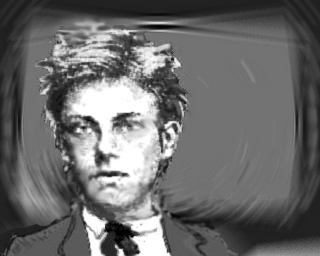
EXODUS
III - " Movement of Jah People "
| V.F. | Reputation |
 |
EXODUS III - " Movement of Jah People " |
|
I & I
"
Now I can say that art is a silly thing "
(draft copy of his "Pagan Book" or "Niger Book" started
before he thougnt to go to Africa and never finished).
... That may be why since then the 7th (cinema), the 8th (photo), the 9th (comics) and the 10th art (video-art) have been invented.
It is said he had a great knowledge of local flora and this erudition gave him precious indication about the altitude and the situation of places. Unlike other White people who had settled near the town centre, Arthur stayed with the locals. He had expensive scientific books delivered to his place (although books are heavy). We can tell he was interested in astronomy from his readings. it is often left out that Arthur Rimbaud indulged in the art of photography using the best camera one could find at the time (but what remains of these stills ?)
Arthur Rimbaud knew about ten languages and dialects. He could read local writing used in very ancient apocryphal texts. Another kind of poetry ... So to say, he could read the Bible in the original text and see history in original version. And may be this reading and concern for an active involvement in everyday life, as already described, urged Arthur to leave for this remote land. Who Knows ?
---=|=---
In any case the parallels between Rimbaud’s comet-like trajectory and the essential cultural movements, for example rastafarism, are more numerous that we think. Let’s notice a semantic correlation between the famous assertion of the Voyant’s letter.
"I is somebody else" and the famous leitmotiv of rasta talk "I and I".
"I" is
somebody else so "Somebody else" is "I".
Both
extremes come together
:revengeful individualism of former slave and an attempt to free the
poet of his ego. "I and I" stand for "us" since we are two other selves
(Indeed the use of"you" or "we" is dismissed by rastas. "I
and I" best illustrates brotherhood, equality in the very
assertion of one’s identity (a relative one with Rimbaud as
with the submissive coloured people). By extension, the number one in
Greek numeral from "Selassié 1" has become "I" pinpointing
the respectful affinity and superbly fulfilling Rimbaud’s
phrase "the right for the difference" as a search of identity.
That’s how, almost a century after Rimbaud’s last trip (10000 km with an injured leg *, plus a return by train Marseilles-Roche ...That is nearly the length of France from south to North and North to South; with just one leg and in poor health), another saga was born ...

Correlations :
That of Bob Marley * (also son of a serviceman away from home) and whose life was as short (37 years). One died in 1891 and the other in 1981 (same number in a different order) and sang his desire to come back to the land of his ancestors, Ethiopia.
* Both were victims of injured leg : (Bob from the foot, playing foot-ball, and Athur from the knee, riding horse) : because of their way of life "on the edge" ... with more spiritual occupations than physical worries ...)
The exodus hab been completed
earlier on by his French colleague Arthur Rimbaud. And this song
allowed a whole people long subjugated in slavery to hold their head
high again for good but he also got the nerve to tour the whole world.
For the first time in history from the media in Mexico suburbs to the
streets of Katmandou via Russia, from the juke box of a harbour bar in
Ghana to a Norwegian fastfood, through the radio of an eskimo or the
tape of a Chinese, through a chic French night club, and cable TV in
Japan, the music spontaneously hit the top in the charts.
Others have fitted in the space left by the singer after he’d
left but neither Ludwig Van Beethoven nor Elvis Presley succeeded in
keeping up with such an exploit. We still haven’t got over it.
As far as Arthur Rimbaud is concerned he almost managed to find a place where even his shadow could not trace him, where he could find himself at peace, he had already come over (the exodus).
" He felt bound to the impossible "
(Alain Borer about Arthur R.)
|
|
||||||
| i n t r o |
|
|
|
|
|
|